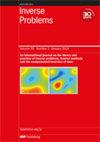曲线上有源的受限横向射线变换的反演
IF 2
2区 数学
Q1 MATHEMATICS, APPLIED
引用次数: 0
摘要
本文研究了作用于矢量场和对称 m 张量场的受限横向射线变换。我们利用受限横射线变换数据开发了反演算法,以恢复 R3 中的对称 m 张量场和 Rn 中的矢量场。我们将横向射线变换限制为通过满足基里洛夫-图伊条件的固定曲线 γ 的所有线段。我们证明,已知的受限数据可用来重建未知矢量/张量场分量的特定加权拉顿变换,然后用它来明确恢复未知场。本文章由计算机程序翻译,如有差异,请以英文原文为准。
Inversion of a restricted transverse ray transform with sources on a curve
In this paper, a restricted transverse ray transform acting on vector and symmetric m -tensor fields is studied. We developed inversion algorithms using restricted transverse ray transform data to recover symmetric m -tensor fields in
R 3 and vector fields in
R n . We restrict the transverse ray transform to all lines going through a fixed curve γ that satisfies the Kirillov–Tuy condition. We show that the known restricted data can be used to reconstruct a specific weighted Radon transform of the unknown vector/tensor field’s components, which we then use to explicitly recover the unknown field.
求助全文
通过发布文献求助,成功后即可免费获取论文全文。
去求助
来源期刊

Inverse Problems
数学-物理:数学物理
CiteScore
4.40
自引率
14.30%
发文量
115
审稿时长
2.3 months
期刊介绍:
An interdisciplinary journal combining mathematical and experimental papers on inverse problems with theoretical, numerical and practical approaches to their solution.
As well as applied mathematicians, physical scientists and engineers, the readership includes those working in geophysics, radar, optics, biology, acoustics, communication theory, signal processing and imaging, among others.
The emphasis is on publishing original contributions to methods of solving mathematical, physical and applied problems. To be publishable in this journal, papers must meet the highest standards of scientific quality, contain significant and original new science and should present substantial advancement in the field. Due to the broad scope of the journal, we require that authors provide sufficient introductory material to appeal to the wide readership and that articles which are not explicitly applied include a discussion of possible applications.
 求助内容:
求助内容: 应助结果提醒方式:
应助结果提醒方式:


